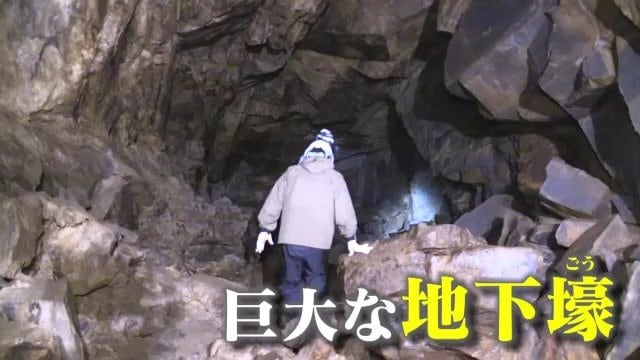Delving into the heart of the matter. This time, it’s an underground bunker built by the former Imperial Japanese Army, discovered for the first time this year—80 years after the war. A war relic left to decay in obscurity. What story does it tell?
Kakamigahara City, Gifu Prefecture. A gaping hole in the side of “a certain mountain”… A massive underground bunker existed here.
Discovered this year, marking 80 years since the war’s end—what was this structure built for, and by whom? For the first time, a television camera entered the site.
An 85-year-old man living near the bunker, who also owns the surrounding mountain, recalls that as the war neared its end, many soldiers stayed in his outbuilding and nearby houses.
“This was my family home before the war. Soldiers stayed in this room—two eight-tatami rooms where troops were stationed. They would line up in front of the house, singing military songs and following orders from their superiors. They did this morning and night.”
It is said that narrow-gauge railway tracks were laid in the area, possibly to transport supplies. Guided by the man, we headed toward the site in question.
“There used to be tracks laid here. It was originally a public road, but the military installed rails leading directly to the underground bunker.”
Being a child at the end of the war, the man did not know exactly what the military was doing.
huge underground bunker
The huge underground bunker, often associated with Cold War-era military installations, was designed to protect personnel and vital operations from nuclear attacks. Many such bunkers, like the famous Cheyenne Mountain Complex in the U.S. or the Kelvedon Hatch Secret Nuclear Bunker in the U.K., were built in the mid-20th century as government or military command centers. Today, some have been declassified and repurposed as museums or tourist attractions, offering a glimpse into Cold War history.
Imperial Japanese Army
The Imperial Japanese Army (IJA) was the ground force of the Empire of Japan from 1868 until its dissolution in 1945 after World War II. Established during the Meiji Restoration, it played a major role in Japan’s expansionist wars, including the Sino-Japanese War (1894–95), Russo-Japanese War (1904–05), and World War II. Known for its strict discipline and brutal tactics, the IJA was disbanded following Japan’s surrender in 1945 and replaced by the Japan Self-Defense Forces under postwar pacifist reforms.
Kakamigahara City
Kakamigahara City, located in Gifu Prefecture, Japan, is known for its rich aviation history and aerospace industry, stemming from its former role as a key Imperial Japanese Army airbase during World War II. Today, it houses the Kakamigahara Aerospace Science Museum, showcasing the city’s aviation heritage. The city also features lush parks, like the Kakamigahara Kōen, and is recognized for its agricultural production, particularly pears and grapes.
Gifu Prefecture
Gifu Prefecture, located in central Japan, is known for its rich history, stunning natural landscapes, and traditional crafts. It was a strategic region during the Sengoku period (15th–16th centuries) and is home to the historic Gifu Castle, as well as the picturesque Shirakawa-go village, a UNESCO World Heritage Site famous for its traditional gassho-zukuri farmhouses. The prefecture is also renowned for cormorant fishing (ukai), a centuries-old practice on the Nagara River.
certain mountain
Certainly! Here’s a concise summary of a notable mountain, such as Mount Everest:
*Mount Everest, the world’s highest peak at 8,848 meters (29,029 feet), is located in the Himalayas on the border of Nepal and Tibet. First successfully summited by Sir Edmund Hillary and Tenzing Norgay in 1953, it holds deep cultural and spiritual significance for local communities, including the Sherpa people, who regard it as sacred.*
If you have a *specific* mountain in mind, let me know, and I can tailor the summary accordingly!
narrow-gauge railway tracks
Narrow-gauge railway tracks, with a smaller distance between rails than standard gauge, were historically developed for cost-effective transportation in rugged or constrained terrains, such as mountains, mines, and plantations. They became popular in the 19th and early 20th centuries, particularly in industries like logging and tourism, offering efficient movement of goods and passengers where space or resources were limited. Today, many preserved narrow-gauge railways operate as heritage attractions, showcasing vintage locomotives and scenic routes.
gas masks
Gas masks are protective devices designed to shield the wearer from inhaling harmful pollutants, toxic gases, or chemical agents. First widely used during World War I in response to chemical warfare, they have since been employed in military, industrial, and emergency settings. Modern gas masks also serve as symbols of preparedness, often associated with historical conflicts, Cold War fears, or environmental disasters.
medicine bottles
Medicine bottles are containers historically used to store and dispense medicinal substances, ranging from ancient pottery and glass vessels to modern plastic and glass vials. Their design evolved alongside advancements in medicine and pharmacy, often featuring labels, embossing, or colored glass to protect contents from light. Collectible today, antique medicine bottles offer insights into early medical practices and pharmaceutical history.






